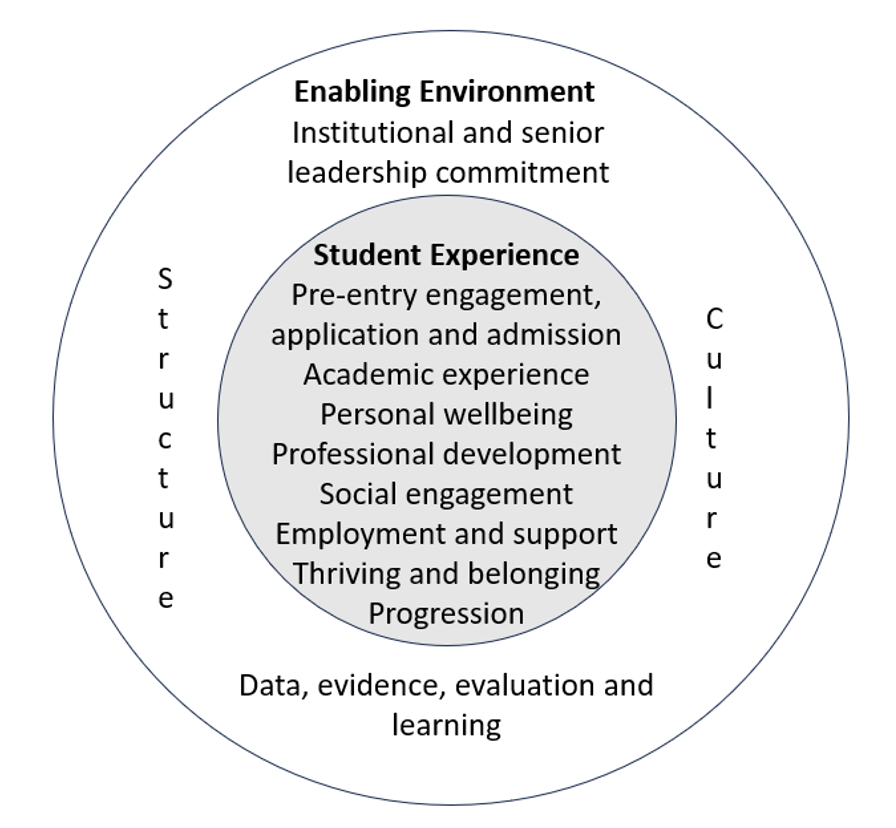A “whole provider approach” is required.
Isn’t that what an Access and Participation Plan is asking you to do anyway?
So in an access and participation plan, what should providers include in the “whole provider approach” section?
Building on previous research and an analysis of wave 1 Access and Participation Plans (APPs), we have been working with 28 higher education providers to help answer these and other knotty questions.
The vast majority of higher education providers in England are currently engaged in writing or finalising their APP, and a whole provider approach is one of the challenges to be addressed.
A whole provider approach is however also of interest to those not required to submit an APP (see for example whole-of-institution work in Australia) – not least because the phrase (or versions of it) appear in any number of policy and regulatory documents.
In short, a whole provider approach focuses on widening access and student experience interventions operating across the whole institution, contributing to consistency and equity for all students.
Alignment
It involves institutional alignment – ensuring that policies, processes, practices and resources match institutional commitments and student characteristics, by working across “traditional organisational boundaries”.
Vertical alignment involves working throughout the student lifecycle from access to progression, while horizontal alignment addresses the full lived experience of students, including for example the academic and wider student experience, plus other commitments, responsibilities and (potentially) challenges.
A whole provider approach requires staff from departments, services and units from across the institution being involved in widening access and student success – not just “professional widening participation” staff – and ideally for them to work in partnership with students.
The APP process requires institutions to assess their access, continuation, completion awarding and progression performance in relation to different groups of students, and then to review the risks to develop understanding about why differences or gaps exist.
Once complete, institutions should identify priorities, set objectives and develop intervention strategies and associated evaluation plans. These interventions are likely to range from pilots designed to address and test out an approach to a specific challenge, through to whole-institution interventions designed to transform the student experience and student outcomes.
Arguably, the longer-term goal is for equality, diversity and inclusion to be embedded into the student experience through “business as usual” – and to deliver equity (i.e. equality of outcomes).
Environment
Past experience identified institutional level challenges that impede embedding equity into the student experience at more local levels. A whole provider approach not only refers to student experience interventions across the whole institution, but also to the existence of an “enabling environment” to facilitate institutional transformation.

The enabling environment consists of four dimensions:
- Institutional and senior leadership and commitment to diversity and success, which is explicit, clearly communicated and demonstrated.
- Institutional policies and processes (structure) aligned to support widening access and student success, and the coordination of work across the higher education provider.
- All staff and students understand the institutional commitment, and have the relevant skills, knowledge and support to engage with the agenda, and effective communication facilitates engagement.
- Widening access and student success work is underpinned by data, evidence, evaluation and learning.
A key question to answer in relation to the APP is whether student experience work is identified as an “intervention strategy”, or part of the “whole provider approach”?
Some interventions will clearly be designed and implemented to address risks of equality and achieve institutional objectives, while others may have been developed and embedded as part of a previous APP, and now be part of mainstream provision. The latter may therefore be better located within the whole provider approach section.
Similarly, some aspects of the student experience may be delivered as part of institutional core “business and usual”. For example, recruitment, inclusive learning and teaching, student wellbeing services, careers services.
If these activities support the overall APP objectives, they should probably be included in the whole provider approach section. It may however be worth monitoring or even evaluating business as usual activities to ensure that students from target groups benefit proportionately from these aspects of the core student experience.
In the longer-term, it should be hoped that more interventions and activities become part of the whole provider approach, rather than an intervention strategy.
What’s been approved so far?
A review of the first APPs to be published provides some illustrative examples of ways in which higher education providers are working to develop their enabling environment:
- Introducing governance structures that engage staff and students from across the institution, and which actively involve senior managers and report to governing bodies.
- Building equality, diversity and inclusion into quality assurance processes.
- Ensuring alignment between People Strategy and APP.
- Staff induction and development, mandatory training, staff reward and recognition schemes.
- Localised planning and evaluation in academic departments and professional services to align with APP objectives.
- Student co-creation roles.
- Developing capacity to use institutional data to send targeted messages to students about academic and wellbeing support.
- Improving staff access to and understanding of data and building evaluation skills and capacity.
As part of our programme of support we have developed a set of reflective tools, designed to encourage reflection and development towards a whole provider approach to widening access and student success.
The concept of whole provider approach is weakly developed – but developing an empirically-based framework may be a useful way to prompt thinking, and develop higher education providers… as a whole.













Thankfully the OFS refers to ‘Equality of Opportunity’ and has not adopted the Marxist favoured ‘equity’ that is far more destructive of society and meritocracy, used by the author.